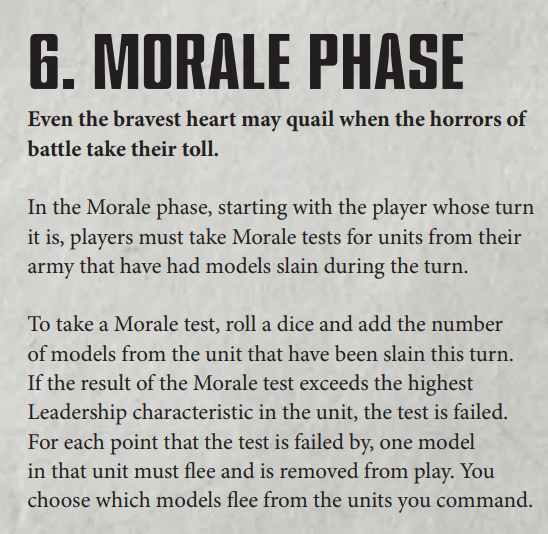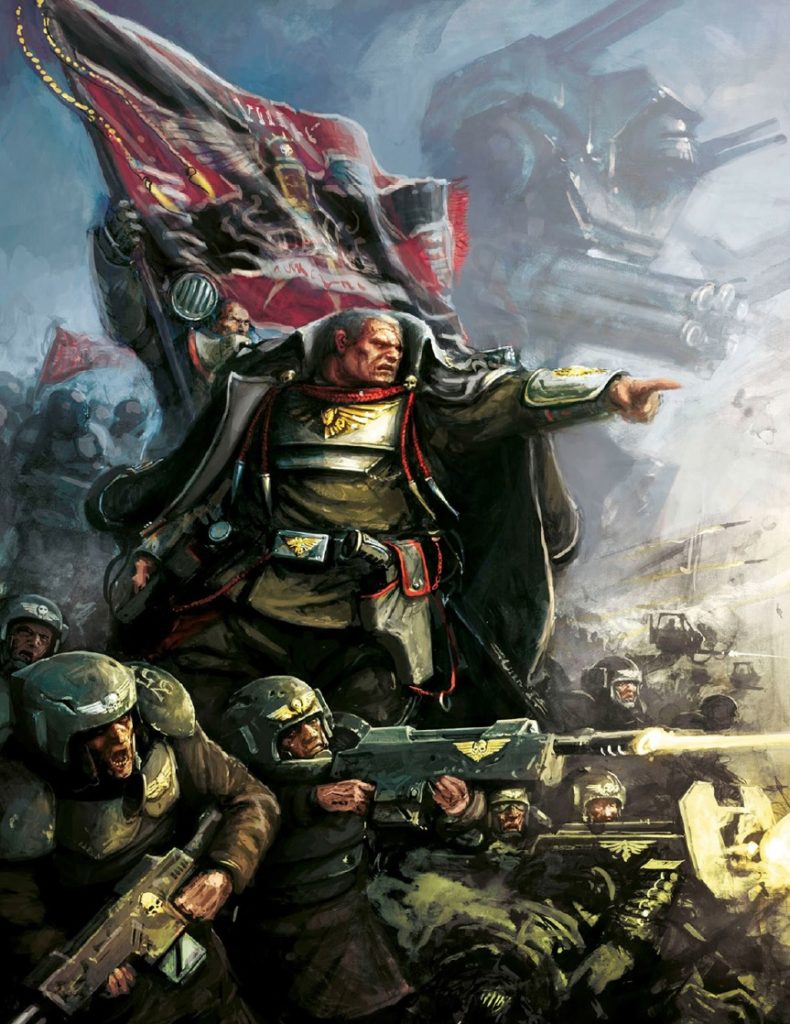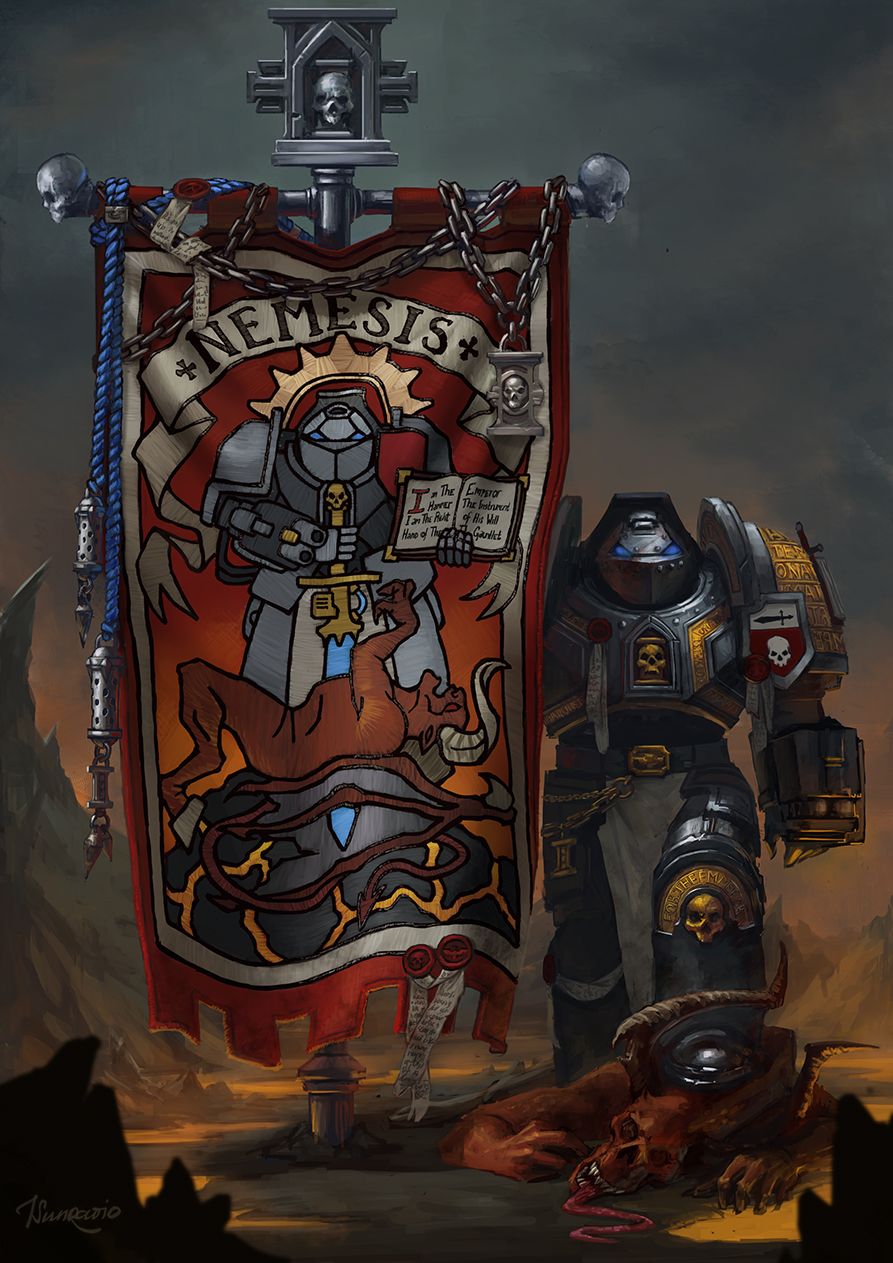The Vets among us may recall a time. A time when gas was cheap. A time when politicians were honest, when children listened to their parents, when the news was reasonable, and when Leadership in 40k actually mattered. Alas, such times have passed us by, and we find ourselves instead in today’s times. Read on to see what can be done about this!

The idea of Leadership, Morale, and units panicking has been in 40K since its inception. The days of Rouge Trader had rules for units routing, running, and rallying. This trend was continued up through 7th edition, with the peak of rules in 4th and slowly cutting them back from there. There was a differentiation between Morale, breaking and running, and Leadership, which was used for a variety of other scenarios as detailed in that edition. One example of a Leadership test was pinning tests – seeing if a unit took cover from incoming fire etc. Leadership was used for everything from picking targets to shoot at to losing hand to hand combats to suffering the ill effects of being in a transport when it exploded.
Without going into a full history of the different ways the Leadership characteristic has been implemented over the editions, I wanted to take a look at how 8th is utilizing it. Or rather, under utilizing it. When 8th edition first dropped it was geared towards simplifying and streamlining the game. To that effect Leadership was relegated to only the Morale phase and any psychic powers that may directly key off it.

While this rule, in and of itself, seems to lend to a different way of doing damage to an enemy unit, in reality it amounts to very little. Most armies that want to run large units, and would therefore be susceptible to it, have relatively easy ways to bypass Morale tests or limit their impact. This amounts to the Morale aspect of the game being more or less irrelevant. Many items, warlord traits, relics in almost every codex have a way to negatively impact enemy leadership. And, due to the myriad of ways to ignore this, these choices are relegated to the bottom of the pile.
So, how can this be addressed, without making it overpowered? Anyone who recalls sweeping advances in 4th edition will know what I mean. I have a few ideas to share. In many of them I will refer to a Leadership (LD) test. This is the idea of rolling 2d6, and wanting to get equal or lower than the LD value of the highest in the unit. So, a unit of Marines would be LD 8 whilst their Sargent is alive and LD 7 if he is not, before any modifiers. A roll of 8 or less on 2d6 would see that unit pass the test, while a 9+ would see them fail.

- Prior to 8th edition, a lot of units would tag a unit in combat to make themselves safe from enemy shooting. With the universal ability of units to fall back now, it makes it much, much harder for melee units to remain safe. It is for this reason that the concept of wrapping was invented to try and safeguard these units. It is a very powerful ability, and we are seeing other units such as wyches and white scars getting access to abilities to likewise prevent enemy units falling back. What I propose it to make the falling back mechanic an LD test. This does several things – first it makes armies like Night Lords who can stack multiple LD penalties with multiple units want to gang up on a unit. Second, it gives melee units a chance to not have a unit they just tagged fall out from under them.
- There used to be a mechanic called pinned, which could apply in a variety of situations. One of the ones that really made sense to me was when a transport blew up from under them they could get pinned. My thought is when a transport is destroyed, on a failed LD test, the unit has it’s move, advance, and charge rolls halved, and are -1 to shoot in their next turn. This is coupled with the idea that a unit only suffers casualties if the transport explodes, nit just destroyed. (Yes, that is two mechanics, and one not related to LD, but I feel if talking about assessing additional penalties to transported units, then the potential changes needs to be taken as a whole). This trade-off of less actual damage to a unit but for a possibility of that unit being shaken up should their ride die.
- Last idea I have for making Leadership relevant again has to do with psychic test. A psycher may, once per phase, before casting or denying a power choose to push their connection with the Warp. They may immediately take a mortal wound and if they survive, take a LD test. On a successful test, they get +1 to cast or deny the next power.
As a quick, but not exhaustive listing of Leadership items and effects not currently being used, and which if LD was made relevant, could find a place in the game:
- Space Marines have: Reivers, the Fearsome Aspect Successor Trait, the Fear Made Manifest warlord trait, and the Standard of the Emperor Ascendant relic banner – just to name a few
- Chaos has: Harrken Worldclaimer, Raptors, Icon of Despair, Night Lords Chapter Tactic, the Entropic Knell relic, and the Slaaanesh Powers Cacophonic Choir and Phantasmagoria.
- Imperial Guard has: the Regimental Standard War gear, Mordian Chapter Tactic, the Terrifying Visions psychic power and the Skull Mask of Acheron relic.
- Necrons have: Flayed ones, the Nightmare Shroud and Abyssal Staff relics.
- Aeldari have: Swooping Hawks and Bahharoth, Hemlock’s Mindshock Pods, Incubi and Drazhar, Phantasm Grenade Launchers and Hallucinogen Grenade Launchers, the Splintermind Drug, the Mantle of Agony ability from Power from Pain, the Biel-Tan, Silent Shroud, and Dark Creed Chapter Tactics, the Pray they don’t take you alive Stratagem and the Psychic powers Horrify, Mind War, and Shards of Light.
- Tyrinads and their ilk have: Locus, the Monstrous Bio-Horrors strat, the Horror and Psychic Scream powers, and the Infrasonic Roar relic.
- Orks have: Boss Snikrot and the Roar of Moark psychic power
I am sure there are many others and combinations of which I have not listed. The point is, this whole phase and aspect of the game is underutilized within 8th edition, and could add some interesting tactical tools to a canny general’s toolbox.
These ideas need not all be implemented, but are just a few of the ones I have had rattling around in my head about how to make Leadership matter again. Take a look through your codex, at those oft-overlooked abilities and traits you have that influence LD and think what would make them worth taking.
Thanks for reading, and happy Wargaming!
And remember, Frontline Gaming sells gaming products at a discount, every day in their webcart!




Yeah, I remember leadership. Running tau from 5th through 7th, it generally meant the pinning quality on certain weapons was useless, and losing 1-2 members of a squad would cause the rest to spend the rest of the game running off the board.
Indeed, that was not a fun mechanic. You may have noticed that none of my proposed ideas had anything to do with units running off the board though. Leadership has never been balanced, and I think 8th having cut out most of it was good, but we can refine it a touch more here to make it better.
“Make Leadership great again” kinda implies that it was ever great, though. Morale has always been a really problematic mechanic in 40K and has never really felt “right,” but I would argue that 8th edition has done it better than the others- rather than being a completely binary “you succeed and absolutely nothing happens or you fail and the unit is functionally destroyed” roll, the current morale phase at least has gradation of failure that can result in different kinds of results.
(Of course, there is still the problem of autopass and autofail, trivial results, scaling, etc, etc, but many of these were endemic to the system already.)
Indeed, and kids have never obeyed their parents fully, nor have politicians been honest nor the news reasonable…
I am not sure 8th has done it the best – I don’t know when I would say was the best overall. There were aspects of leadership and Morale that have been better in some parts throughout the editions. The gradation of failure is a step in the right direction for morale tests. That being said, outside of Morale, leadership is basically not used. I by no means want to go back to units fleeing off the board, but I also think there were some mechanics (pinning tests to a degree) that did not need to get completely tossed out. Like with vehicles, Leadership I feel is still not fully balanced.
They definitely could do more with it- having weapons that interacted with leadership (either to do damage or to force Pinning-style rolls) would be an interesting avenue to take, certainly.
A “proper” wargame probably also would have more detailed morale rules, as many historical or pseudohistorical ones do. However, part of 40K’s problem with morale has always been that, canonically, every single faction in the game is unfailingly and unswervingly loyal and will always fight to the last man every single time no matter what, which doesn’t leave a lot of narrative room for morale to be a thing. Tyranids and Necrons are literally mindless. Orks and Daemons exist only to fight. Space Marines know no fear. Guardsmen are controlled by commissars and Tau by Ethereals. Sisters have their faith. AdMech have their emotions stripped away. Etc.
And other games with the same basic problem of “everyone should be fearless” have removed moral and use command only for special rules and unit consistency.
Now, while the scale of fearlessness is a bit absurd, even we scale back the fearless faction, there’s at least 3 entire factions whose base concept is that morale make no sense for them. Which mean any rules or weapon based on morale is extremely hit and miss, even in an ideal world where we redesignate everything.
Also, being fearless in real life is actually a mixed blessing (it mean your soldiers won’t retreat to fight another day if the odds are too overwhelming, in particular), on the tabletop it’s almost entirely an advantage because even if you only have 3 guardsman conscript surviving, it can force the opponent to fall back and generally be in the way. So while it would make sense for both Necron and Tyrannid to have models “flee” in order to lose that battle but be more likely to win the war, it never make sense on a W40K game.
Basically every time GW has made Morale more important in 40K, the overall player base has complained about it, and eventually basically everyone gets something to mitigate or ignore it. I don’t know that I’d agree entirely with AP that the current version is better than all the previous ones, but it does feel like the most functional of them. None of them did much by the end of their Edition, but at least this one doesn’t waste as much time.